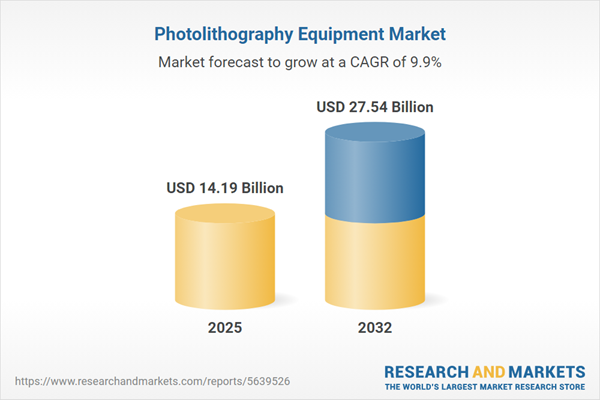Speak directly to the analyst to clarify any post sales queries you may have.
Senior executives operating in the photolithography equipment market are confronted with a fast-moving landscape shaped by constant technological development, evolving global supply chains, and complex sourcing decisions. Effective strategies in this sector require balancing innovation with robust procurement policies and vendor partnerships to secure enduring growth and maintain a strong competitive stance.
Market Snapshot: Photolithography Equipment Market Size and Growth Drivers
The global photolithography equipment market is expected to expand from USD 12.92 billion in 2024 to USD 14.19 billion in 2025, reaching USD 27.54 billion by 2032 with a CAGR of 9.92%. This upward trend is powered by rising demand for advanced lithography technologies, as leading semiconductor manufacturers increase investments in both scaling and improving their fabrication processes. The sector sees growing adoption of next-generation procurement strategies and sophisticated engineering methods. Geographic diversification of supply chains and increasingly sophisticated manufacturing requirements open space for both established firms and new participants to build their presence and drive operational improvements across regional and international markets.
Scope & Segmentation: Photolithography Equipment Market
Thorough segmentation provides decision-makers with detailed insights necessary to refine investment strategies and target specific opportunities. Catering to operational, technical, and customer-driven needs, effective segmentation supports optimal resource allocation and sharper competitive focus.
- Product Types: Scanners and steppers are tailored to distinct wafer processing scenarios, adapting to an array of semiconductor technology applications.
- Implementation Modes: Both in-house and outsourced models help organizations align photolithography assets with their overall operational and strategic goals.
- Wavelengths: Deep ultraviolet and extreme ultraviolet technologies play crucial roles in achieving the miniaturization required for semiconductor innovation.
- Customer Profiles: Operational requirements differ for foundries, integrated device manufacturers, and outsourced semiconductor assembly and test vendors, influencing process integration strategies.
- Applications: Logic chip production, memory manufacturing—covering DRAM, NAND, and other needs—and specialty foundry uses each demand distinct process control standards and ongoing workflow optimization.
- Regional Coverage: Americas, EMEA, and Asia-Pacific regions feature variable supplier ecosystems and regulatory environments, shaping localized procurement, compliance, and partnership approaches.
- Company Analysis: Industry benchmarks range from ASML Holding N.V., Nikon Corporation, and Canon Inc., to Veeco Instruments Inc., SÜSS MicroTec SE, EV Group GmbH, and Shanghai Micro Electronics Equipment (Group) Co., Ltd., providing critical data for informed vendor assessment.
Key Takeaways for Senior Decision-Makers
- Advanced platforms for photolithography enable manufacturers to achieve tighter process standards and adjust quickly to shifting application demands.
- Integrating the latest process technologies keeps production in step with a rapidly evolving semiconductor landscape and emerging usage requirements.
- Utilization of analytics and artificial intelligence for equipment maintenance enhances overall reliability of complex manufacturing plants and improves asset uptime.
- Scalable hardware design, combined with adaptable service agreements, allows organizations to manage changing production volumes efficiently across multiple sites.
- Partnerships with suppliers, technology leaders, and industry standardization groups help speed up the adoption of new production nodes and advance equipment capabilities.
- Adapting sourcing and compliance strategies by region bolsters supplier relationships and enhances risk management throughout diverse regulatory environments.
Tariff Impact: Navigating U.S. Trade Policy and Global Supply Chains
Adjustments to U.S. trade policy have increased compliance complexities for photolithography equipment vendors. Organizations are rethinking sourcing models to sustain operational steadiness, investing in regional supplier networks and expanding vertical integration. Proactive anticipation of regulatory trends, alongside rapid response strategies, remains vital for minimizing disruption and supporting consistent performance in global markets.
Methodology & Data Sources
This market outlook was developed through detailed secondary research, coupled with interviews and surveys involving equipment suppliers, industry experts, and procurement professionals. This approach captures a comprehensive view of market segmentation, procurement best practices, and evolving investment priorities within the photolithography equipment sector.
Why This Report Matters
- Enables executive teams to target high-value market segments and synchronize technology investments with both industry trends and customer priorities.
- Clarifies emerging risks and challenges across regulatory, sourcing, and procurement functions, supporting agile, risk-managed decision-making.
- Equips organizations to perform more effective supplier evaluations and optimize procurement to sustain competitiveness in the sector.
Conclusion: Strategic Guidance for Market Leadership
By understanding market segmentation and current industry dynamics, senior leaders can strengthen operations, cultivate effective supplier partnerships, and steer their organizations toward lasting leadership in the photolithography equipment market.
Additional Product Information:
- Purchase of this report includes 1 year online access with quarterly updates.
- This report can be updated on request. Please contact our Customer Experience team using the Ask a Question widget on our website.
Table of Contents
3. Executive Summary
4. Market Overview
7. Cumulative Impact of Artificial Intelligence 2025
Companies Mentioned
The companies profiled in this Photolithography Equipment market report include:- ASML Holding N.V.
- Nikon Corporation
- Canon Inc.
- Veeco Instruments Inc.
- SÜSS MicroTec SE
- EV Group GmbH
- Shanghai Micro Electronics Equipment (Group) Co., Ltd.
Table Information
| Report Attribute | Details |
|---|---|
| No. of Pages | 186 |
| Published | November 2025 |
| Forecast Period | 2025 - 2032 |
| Estimated Market Value ( USD | $ 14.19 Billion |
| Forecasted Market Value ( USD | $ 27.54 Billion |
| Compound Annual Growth Rate | 9.9% |
| Regions Covered | Global |
| No. of Companies Mentioned | 8 |









